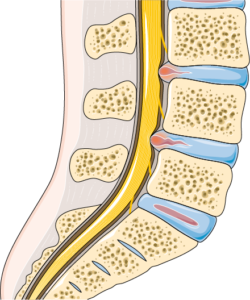Back in 1989, it was estimated that about 2.5 million U.S. workers suffered from low back pain, and low back pain has even been talked about as one of the largest causes of disability in the world. Intervertebral disc degeneration is one of the most common reasons for low back pain in adults. In order to understand how disc degeneration occurs and causes pain, it is important to examine the structure and function of discs in the back.
Discs are structures that sit in between vertebrae in the spine (blue in the image). Their consistency has been compared to Jell-O and the seemingly mythical product called the waterbed. This consistency comes about because of the microstructure of the discs. The main structural component is collagen which not only surrounds the discs but also traverses across the fluid-filled center to give support. Collagen is found all over the body in places ranging from bones to eyes. There are many different types of collagen that are able to account for the softness of the cornea and the strength and stiffness of bones. In discs in the back, the collagen that traverses the middle is the same as that found in cartilage, while the collagen that makes up the outer layer is the same collagen found in skin and bones. This gives the discs a strong, thin outer layer surrounding the gel-like center, warranting the comparison to the waterbed.
Because of this structure, intervertebral discs provide support for the spine in compression. The spine can be compressed by activities as simple as carrying a backpack, sitting, or bending over. When these and other activities occur, the vertebrae press in on the discs, causing pressures from about 15 to 300 psi, or pounds per square inch, depending on the activity. For reference, the recommended tire pressure for a car is 30-35 psi and the pressure inside a champagne bottle is 60-90 psi.
As discs degenerate, either with age or trauma, they respond differently to the large compressive stress applied from the spine. With age, this change in response is most commonly attributed to the inside portion of the disc drying up and changing from a gel to a solid. Discs rely heavily on fluid flowing through their pores, and once they dry up, this no longer occurs. As loads are applied, instead of increasing pressure, degenerate discs can expand outward creating a phenomenon known as a bulging disc. While this is just one of the many medical problems a degenerate disc can cause, it is
common and typically leads to an increase in pain. When the discs expand outwards, it reduces the space between the vertebrae causing irritation. If the discs expand far enough outward, they can leave the space between the vertebrae, entering the region where many nerves lie, potentially causing pain throughout the body.
Despite their odd consistency, intervertebral discs play an important role in the spine, sometimes pressurizing to more than 3 times that of a champagne bottle. Both injuries and natural degeneration leads to negative changes in the biomechanical properties of discs, causing an increase in back pain. If you are interested in learning how to take care of your discs, worried you have an injured disc, or simply want to learn more, I recommend going here.
Featured image from Servier Medical Art on Flickr is licensed under CC BY 2.0.


